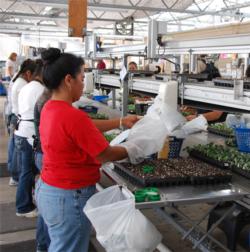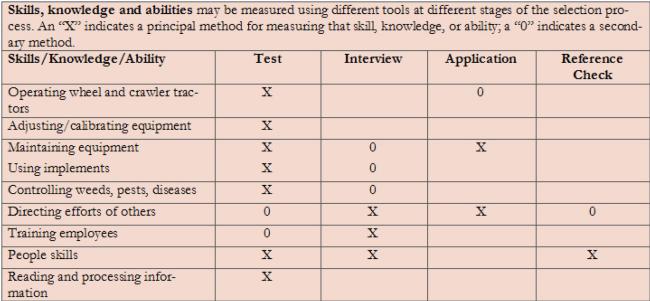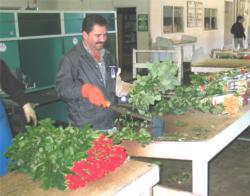Practical Steps to Employee Selection: Designing the Employee Selection Process
by Gregorio Billikopf

The information presented in this article describes one factor that employers need to consider when selecting employees: Designing the employee selection process. A well-designed selection process is critical to determining information about a candidate’s skills and weaknesses. However, several other factors must also be considered in making an informed choice. These include deciding what you need, exchanging information with applicants and bringing the new employee aboard. Detailed information concerning these topics is discussed in the reference link listed at the end of this article.
Step 1: Determine which selection tools to use
In designing the employee selection process, the first step is determining which selection tools to use to evaluate applicant skills. Selection tools include applications, interviews, tests, reference checks, letters of recommendation and physicals. Some selection tools are more effective than others, but a combination of tools is usually best. For example, factors reflecting worker motivation, such as punctuality and attendance, may be elicited within the interview, but contacting previous employers may give more reliable information. If possible, try to verify evidence of specific skills, knowledge and abilities at more than one point in the selection process. Time constraints may limit choices.
The table below lists various selection tools that can be used for measuring specific skills, knowledge and abilities. In selecting which tools to use, it may be helpful to use this table as a template, substituting the skills, knowledge and abilities that are important in the job you are seeking to fill. Think about which tools can provide meaningful information about each attribute. Then, make any necessary modifications in the four right column headings for selection tools (adding columns if additional selection tools are necessary). Mark which tools will be used as primary and secondary methods for each attribute.

Employers may feel strongly about using a one- or two-week trial period to evaluate a potential employee. A trial phase in conjunction with selection tools can be very effective. However, a trial period makes a poor substitute for a systematic selection approach: all too often a candidate that is barely qualified is allowed to stay on. The chances of selecting the right individual for the job based solely on a trial period are greatly diminished.
Step 2: Prepare questions and situations for written and practical tests, the interview and reference checks
The next step is to convert important skill areas into specific questions or activities for the application, interview and tests. Also, questions for the reference check may be drawn up. After you have modified the left-hand column in the table for the specific job you are trying to fill, it can serve as a checklist of attributes to be verified by your selection tools.
Areas of inquiry can help determine an applicant’s aptitude for interpreting plant health distress signs, capability with measuring instruments, command of another language, understanding of labor management principles, lifting strength, or welding expertise. Results are used to assess a candidate’s technical knowledge, general problem-solving ability, interest in the operation and other job-related attributes. Some queries or activities will elicit responses that can be judged objectively, such as how much pesticide should be mixed into a given number of gallons of water. Other responses may be more subjective, such as to an inquiry on how to deal with a negligent employee.
Step 3: Assign a sequence to hurdles
The nursery manager can think of the selection process as a series of hurdles that applicants must clear in order to obtain the job. However, some steps in the selection process should not be a strict hurdle to eliminate applicants from contention. For example, if scores on a records and computer test are used to eliminate contenders for a nursery production manager position, the applicant pool might be narrowed inappropriately to those who understand records and computers but lack important hands-on skills.
The sequence of hurdles needs to be designed with care. However, if there are only a few applicants, progressive hurdles are unnecessary: If all applicants will be interviewed and all take a practical test (or job sample), it does not matter much which of the steps comes first. Similarly, the sequence of selection tools that are not used as hurdles is less important.

The sequence of the next hurdles is often based on expense. Written exams for technical or managerial positions (when ability to write is a requirement) are often less expensive to administer than interviews or practical tests. For this reason, they are an effective early hurdle. Generally, the most expensive and time-consuming selection tools are used later in the selection process. Reference checks and medical screening are usually the last two hurdles. (U.S. law requires that medical screenings, if they are used, take place after a job offer has been made.)
Inviting candidates to participate can include a description of the steps in the process, their sequence and any required applicant preparation. The sequence of hurdles may be programmed to minimize travel and expense for both applicants and employer. A preliminary telephone interview with out-of-state applicants may eliminate unnecessary travel. Written tests can sometimes be mailed out-of-state when they can be administered to applicants by a trusted, qualified third party.
Step 4: Provide a realistic job preview
Applicants who have a clear understanding of what the job entails can make more informed decisions as to whether they want to apply. For instance, will the job meet their financial, emotional and social needs? Selected applicants who have an accurate understanding of the job — of both its desirable and difficult aspects — are more likely to stay and succeed.
When described to workers, conditions do not have to be labeled as positive or negative. Workers can make their own judgment. For instance, working alone will be viewed positively by one applicant and negatively by the next.
The realistic job preview begins with the job announcement and position description. As prospective applicants inquire about the job, nursery managers can provide applications, position descriptions and additional information. Although some employers use the preliminary interview to learn about applicants, the best use of this selection tool is to provide information to applicants.
If interviews as well as practical and written tests truly mirror the job requirements, these can also help candidates understand the job. For example, if an applicant must demonstrate lifting as part of the practical exam, he may eliminate himself if he has a bad back.
Gregorio Billikopf is Farm Advisor, UC Cooperative Extension, Modesto, Merced and San Joaquin Counties.
This article is an excerpt adapted by Steve Tjosvold and Julie Newman from “Practical steps to employee selection,” In: Labor Management in Agriculture: Cultivating Personnel Productivity, 2003 http://www.cnr.berkeley.edu/ucce50/ag-labor/7labor/02.pdf.












